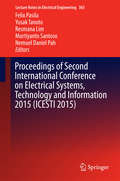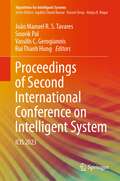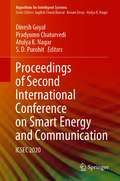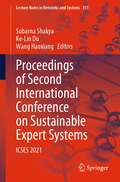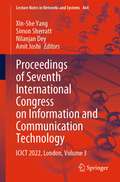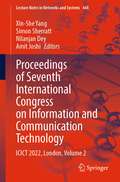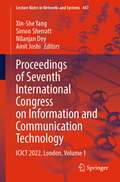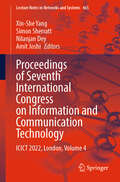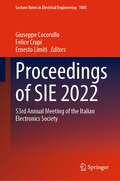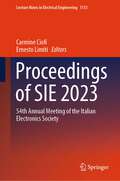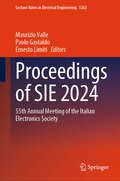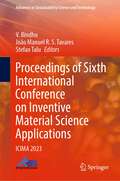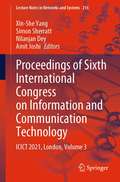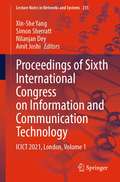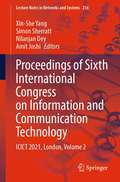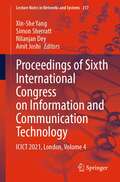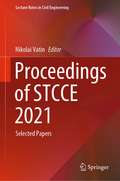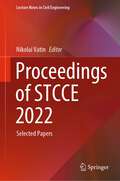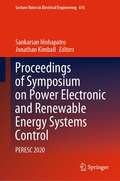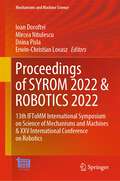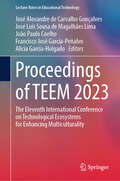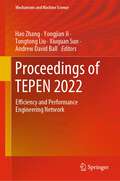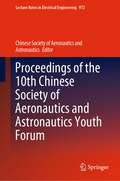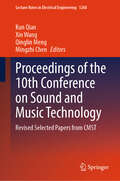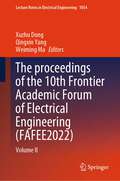- Table View
- List View
Proceedings of Second International Conference on Electrical Systems, Technology and Information 2015 (ICESTI #2015)
by Felix Pasila Yusak Tanoto Resmana Lim Murtiyanto Santoso Nemuel Daniel PahThis book includes the original, peer-reviewed research papers from the 2nd International Conference on Electrical Systems, Technology and Information (ICESTI 2015), held in September 2015 at Patra Jasa Resort & Villas Bali, Indonesia. Topics covered include: Mechatronics and Robotics, Circuits and Systems, Power and Energy Systems, Control and Industrial Automation, and Information Theory. It explores emerging technologies and their application in a broad range of engineering disciplines, including communication technologies and smart grids. It examines hybrid intelligent and knowledge-based control, embedded systems, and machine learning. It also presents emerging research and recent application in green energy system and storage. It discusses the role of electrical engineering in biomedical, industrial and mechanical systems, as well as multimedia systems and applications, computer vision and image and signal processing. The primary objective of this series is to provide references for dissemination and discussion of the above topics. This volume is unique in that it includes work related to hybrid intelligent control and its applications. Engineers and researchers as well as teachers from academia and professionals in industry and government will gain valuable insights into interdisciplinary solutions in the field of emerging electrical technologies and its applications.
Proceedings of Second International Conference on Intelligent System: ICIS 2023 (Algorithms for Intelligent Systems #21)
by João Manuel R. S. Tavares Souvik Pal Vassilis C. Gerogiannis Bui Thanh HungThis book gathers selected high-quality research papers presented at the Second International Conference on Intelligent System (ICIS 2023), organized by Industrial University of Ho Chi Minh City, Vietnam during September 29–30, 2023. It discusses high-quality and cutting-edge research in the areas of informatics, intelligent systems, and smart technologies and applications. The book is a collection of the latest research articles in intelligent control, artificial intelligence, neural networks, knowledge discovery, decision support systems, soft computing, data mining, and ontologies, machine learning, intelligent measurement, and other related fields.
Proceedings of Second International Conference on Smart Energy and Communication: ICSEC 2020 (Algorithms for Intelligent Systems)
by Dinesh Goyal Pradyumn Chaturvedi Atulya K. Nagar S. D. PurohitThis book gathers selected papers presented at the 2nd International Conference on Smart Energy and Communication (ICSEC 2020), held at Poornima Institute of Engineering and Technology, Jaipur, India, on March 20–21, 2020. It covers a range of topics in electronics and communication engineering and electrical engineering, including analog circuit design, image processing, wireless and microwave communication, optoelectronics and photonic devices, nano-electronics, renewable energy, smart grid, power systems and industry applications.
Proceedings of Second International Conference on Sustainable Expert Systems: ICSES 2021 (Lecture Notes in Networks and Systems #351)
by Ke-Lin Du Subarna Shakya Wang HaoxiangThis book features high-quality research papers presented at the 2nd International Conference on Sustainable Expert Systems (ICSES 2021), held in Nepal during September 17–18, 2021. The book focusses on the research information related to artificial intelligence, sustainability, and expert systems applied in almost all the areas of industries, government sectors, and educational institutions worldwide. The main thrust of the book is to publish the conference papers that deal with the design, implementation, development, testing, and management of intelligent and sustainable expert systems and also to provide both theoretical and practical guidelines for the deployment of these systems.
Proceedings of Seventh International Congress on Information and Communication Technology: ICICT 2022, London, Volume 3 (Lecture Notes in Networks and Systems #464)
by Xin-She Yang Simon Sherratt Nilanjan Dey Amit JoshiThis book gathers selected high-quality research papers presented at the Seventh International Congress on Information and Communication Technology, held at Brunel University, London, on February 21–24, 2022. It discusses emerging topics pertaining to information and communication technology (ICT) for managerial applications, e-governance, e-agriculture, e-education and computing technologies, the Internet of Things (IoT) and e-mining. Written by respected experts and researchers working on ICT, the book offers a valuable asset for young researchers involved in advanced studies. The work is presented in four volumes.
Proceedings of Seventh International Congress on Information and Communication Technology: ICICT 2022, London, Volume 2 (Lecture Notes in Networks and Systems #448)
by Xin-She Yang Simon Sherratt Nilanjan Dey Amit JoshiThis book gathers selected high-quality research papers presented at the Seventh International Congress on Information and Communication Technology, held at Brunel University, London, on February 21–24, 2022. It discusses emerging topics pertaining to information and communication technology (ICT) for managerial applications, e-governance, e-agriculture, e-education and computing technologies, the Internet of Things (IoT) and e-mining. Written by respected experts and researchers working on ICT, the book offers a valuable asset for young researchers involved in advanced studies. The work is presented in four volumes.
Proceedings of Seventh International Congress on Information and Communication Technology: ICICT 2022, London, Volume 1 (Lecture Notes in Networks and Systems #447)
by Xin-She Yang Simon Sherratt Nilanjan Dey Amit JoshiThis book gathers selected high-quality research papers presented at the Seventh International Congress on Information and Communication Technology, held at Brunel University, London, on February 21–24, 2022. It discusses emerging topics pertaining to information and communication technology (ICT) for managerial applications, e-governance, e-agriculture, e-education and computing technologies, the Internet of Things (IoT) and e-mining. Written by respected experts and researchers working on ICT, the book offers a valuable asset for young researchers involved in advanced studies. The work is presented in four volumes.
Proceedings of Seventh International Congress on Information and Communication Technology: ICICT 2022, London, Volume 4 (Lecture Notes in Networks and Systems #465)
by Xin-She Yang Simon Sherratt Nilanjan Dey Amit JoshiThis book gathers selected high-quality research papers presented at the Seventh International Congress on Information and Communication Technology, held at Brunel University, London, on February 21–24, 2022. It discusses emerging topics pertaining to information and communication technology (ICT) for managerial applications, e-governance, e-agriculture, e-education and computing technologies, the Internet of Things (IoT) and e-mining. Written by respected experts and researchers working on ICT, the book offers a valuable asset for young researchers involved in advanced studies. The work is presented in four volumes.
Proceedings of SIE 2022: 53rd Annual Meeting of the Italian Electronics Society (Lecture Notes in Electrical Engineering #1005)
by Giuseppe Cocorullo Felice Crupi Ernesto LimitiThis book showcases the state of the art in the field of electronics, as presented by researchers and engineers at the 53rd Annual Meeting of the Italian Electronics Society (SIE), held in Rende (CS), Italy, on September 5-7, 2022. It covers a broad range of aspects, including: integrated circuits and systems, micro- and nano-electronic devices, microwave electronics, sensors and microsystems, optoelectronics and photonics, power electronics, electronic systems and applications.
Proceedings of SIE 2023: 54th Annual Meeting of the Italian Electronics Society (Lecture Notes in Electrical Engineering #1113)
by Carmine Ciofi Ernesto LimitiThis book showcases the state of the art in the field of electronics, as presented by researchers and engineers at the 54th Annual Meeting of the Italian Electronics Society (SIE), held in Noto (SR), Italy, on September 6–8, 2023. It covers a broad range of aspects, including: integrated circuits and systems, micro- and nano-electronic devices, microwave electronics, sensors and microsystems, optoelectronics and photonics, power electronics, electronic systems and applications.
Proceedings of SIE 2024: 55th Annual Meeting of the Italian Electronics Society (Lecture Notes in Electrical Engineering #1263)
by Maurizio Valle Paolo Gastaldo Ernesto LimitiThis book showcases the state of the art in the field of electronics, as presented by researchers and engineers at the 55th Annual Meeting of the Italian Electronics Society (SIE), held in Genoa, Italy, on June 26–28, 2024. It covers a broad range of aspects, including: integrated circuits and systems, micro- and nano-electronic devices, microwave electronics, sensors and microsystems, optoelectronics and photonics, power electronics, electronic systems and applications.
Proceedings of Sixth International Conference on Inventive Material Science Applications: ICIMA 2023 (Advances in Sustainability Science and Technology)
by V. Bindhu João Manuel R. S. Tavares Stefan TaluThe book is a collection of best selected research papers presented at the 6th International Conference on Inventive Material Science Applications (ICIMA 2023) organized by PPG Institute of Technology, Coimbatore, India, during May 11–12, 2023. The book includes original research by material science researchers toward developing a compact and efficient functional elements and structures for micro-, nano-, and optoelectronic applications. The book covers important topics like nanomaterials and devices, optoelectronics, sustainable electronic materials, nanocomposites and nanostructures, hybrid electronic materials, medical electronics, computational material science, wearable electronic devices and models, and optical/nanosensors.
Proceedings of Sixth International Congress on Information and Communication Technology: ICICT 2021, London, Volume 3 (Lecture Notes in Networks and Systems #216)
by Xin-She Yang Nilanjan Dey Amit Joshi Simon SherrattThis book gathers selected high-quality research papers presented at the Sixth International Congress on Information and Communication Technology, held at Brunel University, London, on February 25–26, 2021. It discusses emerging topics pertaining to information and communication technology (ICT) for managerial applications, e-governance, e-agriculture, e-education and computing technologies, the Internet of things (IoT) and e-mining. Written by respected experts and researchers working on ICT, the book offers a valuable asset for young researchers involved in advanced studies. The book is presented in four volumes.
Proceedings of Sixth International Congress on Information and Communication Technology: ICICT 2021, London, Volume 1 (Lecture Notes in Networks and Systems #235)
by Xin-She Yang Nilanjan Dey Amit Joshi Simon SherrattThis book gathers selected high-quality research papers presented at the Sixth International Congress on Information and Communication Technology, held at Brunel University, London, on February 25–26, 2021. It discusses emerging topics pertaining to information and communication technology (ICT) for managerial applications, e-governance, e-agriculture, e-education and computing technologies, the Internet of things (IoT) and e-mining. Written by respected experts and researchers working on ICT, the book offers a valuable asset for young researchers involved in advanced studies. The book is presented in four volumes.
Proceedings of Sixth International Congress on Information and Communication Technology: ICICT 2021, London, Volume 2 (Lecture Notes in Networks and Systems #236)
by Xin-She Yang Simon Sherratt Nilanjan Dey Amit JoshiThis book gathers selected high-quality research papers presented at the Sixth International Congress on Information and Communication Technology, held at Brunel University, London, on February 25–26, 2021. It discusses emerging topics pertaining to information and communication technology (ICT) for managerial applications, e-governance, e-agriculture, e-education and computing technologies, the Internet of things (IoT) and e-mining. Written by respected experts and researchers working on ICT, the book offers a valuable asset for young researchers involved in advanced studies. The book is presented in four volumes.
Proceedings of Sixth International Congress on Information and Communication Technology: ICICT 2021, London, Volume 4 (Lecture Notes in Networks and Systems #217)
by Xin-She Yang Simon Sherratt Nilanjan Dey Amit JoshiThis book gathers selected high-quality research papers presented at the Sixth International Congress on Information and Communication Technology, held at Brunel University, London, on February 25–26, 2021. It discusses emerging topics pertaining to information and communication technology (ICT) for managerial applications, e-governance, e-agriculture, e-education and computing technologies, the Internet of Things (IoT) and e-mining. Written by respected experts and researchers working on ICT, the book offers a valuable asset for young researchers involved in advanced studies. The book is presented in four volumes.
Proceedings of STCCE 2021: Selected Papers (Lecture Notes in Civil Engineering #169)
by Nikolai VatinThis book gathers selected contributions in the field of civil and construction engineering, as presented by international researchers and engineers at the 2nd International Scientific Conference on Socio-Technical Construction and Civil Engineering (STCCE), held in Kazan, Russia on April 21-28 2021. The book covers a wide range of topics including building constructions and structures, bridges, roads and tunnels, building materials and products, construction management, energy efficiency and thermal protection of buildings, ventilation, air conditioning, gas supply and lighting in buildings, innovative and smart technologies in construction, sustainable development, transport system development. The contributions, which were selected by means of a rigorous international peer-review process, highlight numerous exciting ideas that will spur novel research directions and foster multidisciplinary collaborations.
Proceedings of STCCE 2022: Selected Papers (Lecture Notes in Civil Engineering #291)
by Nikolai VatinThis book gathers selected contributions in the field of civil and construction engineering, as presented by international researchers and engineers at the 3rd International Scientific Conference on Socio-Technical Construction and Civil Engineering (STCCE), held in Kazan, Russia on April 21-29 2022. The book covers a wide range of topics including building constructions and structures, bridges, roads and tunnels, building materials and products, energy efficiency and thermal protection of buildings, ventilation, air conditioning, gas supply and lighting in buildings, innovative and smart technologies in construction, transport system development. The contributions, which were selected by means of a rigorous international peer-review process, highlight numerous exciting ideas that will spur novel research directions and foster multidisciplinary collaborations.
Proceedings of Symposium on Power Electronic and Renewable Energy Systems Control: PERESC 2020 (Lecture Notes in Electrical Engineering #616)
by Sankarsan Mohapatro Jonathan KimballThis book includes high-quality research papers presented at Symposium on Power Electronic and Renewable Energy Systems Control (PERESC 2020), which is held at the School of Electrical Sciences, IIT Bhubaneswar, Odisha, India, during 4–5 December 2020. The book covers original work in power electronics which has greatly enabled integration of renewable and distributed energy systems, control of electric machine drives, high voltage system control and operation. The book is highly useful for academicians, engineers, researchers and students to be familiar with the latest state of the art in power electronics technology and its applications.
Proceedings of SYROM 2022 & ROBOTICS 2022: 13th IFToMM International Symposium on Science of Mechanisms and Machines & XXV International Conference on Robotics (Mechanisms and Machine Science #127)
by Ioan Doroftei Mircea Nitulescu Doina Pisla Erwin-Christian LovaszThis volume presents the proceedings of the Joint International Conference of the 13th IFToMM International Symposium on Science of Mechanisms and Machines (SYROM) & the XXV International Conference on Robotics (ROBOTICS), held in Iasi, Romania, on November 17–18, 2022. It brought together researchers, scientists and industry experts involved in the area of mechanisms, mechanical transmissions, robotics and mechatronics, to disseminate their latest research results and exchange views on the future research directions of these fields. The book presents original high-quality contributions on topics such as theoretical and computational kinematics, mechanism design, experimental mechanics, dynamics of machinery and multi-body systems, mechanisms for biomechanics, mechanical transmissions, linkages and mechanical controls, micromechanisms, serial and parallel robots, mobile and collaborative robots, micro and nano robots, sensors and actuators, medical robots, haptics, and virtual reality.
Proceedings of TEEM 2023: The Eleventh International Conference on Technological Ecosystems for Enhancing Multiculturality (Lecture Notes in Educational Technology)
by João Paulo Coelho Francisco José García-Peñalvo Alicia García-Holgado José Alexandre de Carvalho Gonçalves José Luís Sousa de Magalhães LimaThis proceedings volume presents outstanding advances, with a multidisciplinary perspective, in the technological ecosystems that support Knowledge Society building and development. With its learning technology-based focus using a transversal approach, TEEM is divided into thematic and highly cohesive tracks, each of which is oriented to a specific community of interest, including researchers, professionals and students. Informatics and Education are the central issues in the conference tracks, including broad-scope research areas, such as Educational Assessment and Orientation, Human-Computer Interaction, eLearning, Computers in Education, Communication Media and Education, Medicine and Education, Learning Analytics, Engineering Education, Robotics in Education, Mechatronics, Diversity in Education, Gamification and Games for Learning.
Proceedings of TEPEN 2022: Efficiency and Performance Engineering Network (Mechanisms and Machine Science #129)
by Hao Zhang Yongjian Ji Tongtong Liu Xiuquan Sun Andrew David BallThis volume gathers the latest advances, innovations and applications in the field of efficiency and performance engineering, as presented by leading international researchers and engineers at the 2022 conference of the Efficiency and Performance Engineering Network (TEPEN), held in Beijing and Baotou, China on August 18-21, 2022. Topics include vibro-acoustics monitoring, condition-based maintenance, sensing and instrumentation, machine health monitoring, maintenance auditing and organization, non-destructive testing, reliability, asset management, condition monitoring, life-cycle cost optimisation, prognostics and health management, maintenance performance measurement, manufacturing process monitoring, and robot-based monitoring and diagnostics. The contributions, which were selected through a rigorous international peer-review process, share exciting ideas that will spur novel research directions and foster new multidisciplinary collaborations.
Proceedings of the 10th Chinese Society of Aeronautics and Astronautics Youth Forum (Lecture Notes in Electrical Engineering #972)
by Chinese Society of Aeronautics and AstronauticsThe Chinese Society of Aeronautics and Astronautics holds the Youth Science and Technology Forum biannually, which aims to assess the state of aviation science and technology, recognize advanced scientific and technological accomplishments, foster the development of young aviation science and technology talents, and provide a platform for young science and technology workers to track the frontier of science and technology, exchange novel ideas, and accurately meet the needs of the aviation industry.This book contains original, peer-reviewed research papers from the conference. Topics covered include, but are not limited to, navigation, guidance and control technologies, key technologies for aircraft design and overall optimization, aviation test technologies, aviation airborne systems, electromechanical technologies, structural design, aerodynamics and flight mechanics, other related technologies, advanced aviation materials and manufacturing technologies, advanced aviation propulsion technologies, and civil aviation transportation. Researchers, engineers, and students find this book to be a useful resource because the articles provided here discuss the most recent advancements in aviation science and technology.
Proceedings of the 10th Conference on Sound and Music Technology: Revised Selected Papers from CMST (Lecture Notes in Electrical Engineering #1268)
by Kun Qian Xin Wang Qinglin Meng Mingzhi ChenThe book presents selected papers at the 10th Conference on Sound and Music Technology (CSMT) held in June 2023, China. CSMT is a multidisciplinary conference focusing on audio processing and understanding with bias on music and acoustic signals. The primary aim of the conference is to promote the collaboration between art society and technical society in China. In this book, the paper included covers a wide range topic from speech, signal processing, music understanding, machine learning, and signal processing for advanced medical diagnosis and treatment applications, which demonstrates the target of CSMT merging arts and science research together. Its content caters to scholars, researchers, engineers, artists, and education practitioners not only from academia but also industry, who are interested in audio/acoustics analysis signal processing, music, sound, and artificial intelligence (AI).
The proceedings of the 10th Frontier Academic Forum of Electrical Engineering: Volume II (Lecture Notes in Electrical Engineering #1054)
by Xuzhu Dong Qingxin Yang Weiming MaThis book includes the original, peer-reviewed research papers from the 10th Frontier Academic Forum of Electrical Engineering (FAFEE 2022), held in Xi’an, China, in August 2022. It gathers the latest research, innovations, and applications in the fields of Electrical Engineering. The topics it covers include electrical materials and equipment, electrical energy storage and device, power electronics and drives, new energy electric power system equipment, IntelliSense and intelligent equipment, biological electromagnetism and its applications, and insulation and discharge computation for power equipment. Given its scope, the book benefits all researchers, engineers, and graduate students who want to learn about cutting-edge advances in Electrical Engineering.
